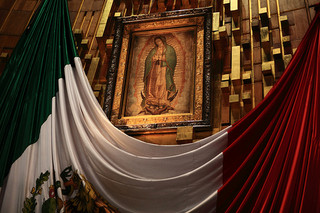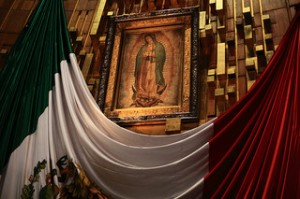La Virgen de Guadalupe, Synonymous with Mexican Identity

 By Phillippe Diederich, Voxxi
By Phillippe Diederich, Voxxi
On the days leading up to December 12, hundreds of thousands of Mexicans will decorate their homes, light candles and begin the pilgrimage to the Basilica de Guadalupe on the outskirts of Mexico City to celebrate and honor the queen of Mexico; Nuestra Señora de Guadalupe.
The celebration of La Guadalupana, as she is sometimes called, is one of the most important holidays in Mexico. It is as much a religious holiday as it is a patriotic holiday because La Virgen de Guadalupe is uniquely Mexican and is one of the country’s most important icons. From the moment of her appearance in 1531 to the present, Juan Diego, she has been a unifying force and a symbol of what it means to be Mexican.
 The story of La Virgen de Guadalupe
The story of La Virgen de Guadalupe
Legend has it the image of the Vigrin Mary appeared to Juan Diego in the hills of Tepeyac while he was on his way to Mexico City. The Virgin told Juan Diego that she wanted a church built in her honor at the top of the hill. Juan Diego told this to the Spanish archbishop, Juan se Zumárraga, who said he needed proof and asked Juan Diego to return to Tepeyac and ask for a miracle from the Virgin.
Juan Diego went back to Tepeyac and told this to the Virgin who helped him harvest flowers from the top of the hill. The flowers were roses of Castille, which did not grow in Mexico, especially during that time of year. Juan Diego carried the flowers back to Mexico City. When he opened his cloak to reveal the flowers at the archbishop’s feet, the image of the Virgin appeared in his cloak. The cloak is now on display at the Basilica.
Taking history into context, and legends aside, the story of La Virgen de Guadalupe and what it did for Mexico cannot be denied. The brown skinned Virgin represented meztisaje, the blending of the Spanish and Indian; what is Mexican. Also, it was common for the Spanish conquistadors to build churches over Aztec temples. At the top of Tepeyac Hill there was a temple where peasants worshipped the Aztec goddess, Tonantzin. Interestingly, the story of Juan Diego and the Virgin was recorded in both Spanish and Nahuatl, the language of the Nahua people.
The Virgin Mary solved problems for the Spanish and the Mexicans
La Virgen de Guadalupe solved big problems for both the Spanish and Mexicans. The Spanish wanted the Indians to become Catholics, but the Indians had their own Gods. La Guadalupana, at least in spirit, offered a path for the Indians and meztisos to become Catholics, because they now had their own deity, acceptable to both the Spanish clergy and the Mexican people. All of this was synthesized even further when father Miguel Hidalgo, holding a banner with the image of the Virgen de Guadalupe, called for the Mexican people to revolt and begin the fight for Independence from Spain.
Ever since then, the image of La Virgen de Guadalupe, has been a part of Mexican identity, lore and inspiration. During the Mexican Revolution, the peasants fighting with Zapata, as well as other revolutionaries, carried her image in banners. She can be found all over Mexico.
Today La Reina de Mexico is presented in so many ways and at so many important functions and celebrations she is synonymous with Mexican identity. Her image can be found in key chains, stickers, t-shirts, caps and even on the inside of Stetson hats and tattoos. La Guadalupana does not just identify people as Catholic, but as Mexican. So on December 12, a sacred and important holiday takes place. Tens of thousands of Mexicans will crowd the area around the Basilica de Guadalupe in Tepeyac, many on their knees, with candles and with pictures of her likeness as they engage in a ritual that is both religious, patriotic and uniquely Mexican.
This article was first published in Voxxi.
Phillippe Diederich is a bilingual writer and photographer born in the Dominican Republic and raised in Mexico City and Miami. His photography has appeared in The New York Times, Timemagazine, U.S. News and World Report and other national publications. His non-fiction has been published in the Traveler’s Tales Anthology, Cuba; Cigar Aficionado; The Miami New Times and The Dallas Morning News. He blogs about Latino issues for VOXXI. Diederich is based in Southwest Florida.
[Photo by Esparta]
